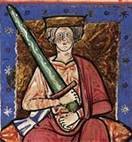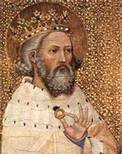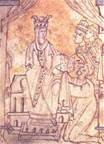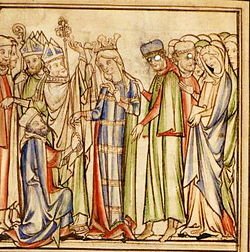EliseLadyofLancaster
Gentry
- Joined
- Aug 2, 2003
- Messages
- 80
Egbert (802-39 AD) Known as the first King of All England, recognised as king of Wessex in 802. In 829, he was proclaimed "Bretwalda" or sole ruler of Britain.
Æthelwulf (839-58 AD) Æthelwulf was the son of Egbert and a sub-king of Kent. He assumed the throne of Wessex upon his father's death in 839. Æthelwulf is remembered, however dimly, as a highly religious man. He was an only child, but had fathered five sons, by his first wife, Osburga. He recognized that there could be difficulties with contention over the succession, so he devised a scheme which would guarantee (insofar as it was possible to do so) that each child would have his turn on the throne without having to worry about rival claims from his siblings.
Æthelbald (858-60 AD) Æthelbald plotted against his father whilst he was on a pilgrimage to Rome. The specific details of the plot are unknown, but upon his return, Æthelwulf found his direct authority limited to the sub-kingdom of Kent, while Æthelbald controlled Wessex. Æthelwulf died in 858, and full control passed to Æthelbald. However, he did not live long to enjoy it. He died in 860, passing the throne to his brother, Æthelbert, just as Æthelwulf had planned.
Æthelbert (860-66 AD) Very little is known about Æthelbert, who took his rightful place in the line of succession to the throne of Wessex at around 30 years of age.
Æthelred I (866-71 AD) Anglo-Saxon king of Wessex, and son of King Æthelwulf, who ruled England during a time of great pressure from the invading Danes. He was an affable man, a devoutly religious man and the older brother of Alfred the Great. Together, they defeated the Danish kings Bagseg and Halfdan at the battle of Ashdown in 870.
Alfred, the Great (871-900 AD) Youngest son of King Æthelwulf, Alfred became King of Wessex during a time of constant Viking attack. Alfred created a series of fortifications to surround his kingdom and provide needed security from invasion. However, the reign of Alfred was known for more than military success. He was a codifier of law, a promoter of education and a supporter of the arts. After his death, he was buried in his capital city of Winchester, and is the only English monarch in history to carry the title, "the Great."
Edward I, the Elder (900-24 AD) Son of Alfred the Great, Edward immediately succeeded his father to the throne.
Æthelstan (924-40 AD) The grandson of Alfred the Great, Æthelstan succeeded his father, Edward the Elder, to the throne of Wessex. He was the first English sovereign ever to be crowned on the King's Stone at Kingston-upon-Thames in 925. Incorrectly claimed by some to be the first King of All England, Æthelstan was a great warrior, nonetheless, whose fame stemmed from his conquests in Cornwall and Wales, and his defeat of a combined force of Scots, Welsh and Vikings at the battle of Brunanburh in 938.
Edmund I (940-46 AD) Son of Edward the Elder, succeeded his half-brother, Æthelstan.
Eadred (946-55 AD) King of Wessex and acknowledged as overlord of Mercia, the Danelaw and Northumbria.
Eadwig (Edwy) (955-59 AD) On the death of Eadred, who had no children, Eadwig was chosen to be king since he was the oldest of the children in the natural line of the House of Wessex. He became king at 16. An incident, which occurred on the day of Eadwig's consecration as king, purportedly, illustrates the character of the young king. According to the report of the reliable William of Malmesbury, all the dignitaries and officials of the kingdom were meeting to discuss state business, when the absence of the new king was noticed. Dunstan was dispatched, along with another bishop, to find the missing youth. He was found with his mind on matters other than those of state, in the company of the daughter of a noble woman of the kingdom. Malmesbury writes, Dunstan, " regardless of the royal indignation, dragged the lascivious boy from the chamber and...compelling him to repudiate the strumpet made him his enemy forever." Eadwig went on to marry Ælgifu, the girl with whom he was keeping company at the time of Dunstan's intrusion. For her part, " the strumpet" was eventually referred to as among "the most illustrious of women", and Eadwig, in his short reign, was generous in making grants to the church and other religious institutions. He died, possibly of the Wessex family ailment, when he was only 20.
Edgar (959-75 AD) Edgar was made King of Mercia and Northumbria in 957 and succeed to the throne of Wessex at his brother, Eadwig's, death in 959. With this, Edgar was King of Mercia, Northumbria and Wessex (the three most powerful kingdoms in England at that time), simultaneously and could be considered the first ruler of a United England.
Edward II, the Martyr (975-78 AD) Elder son of King Edgar, he succeeded to the throne as a boy of 12, and in so doing, aroused rival claims on behalf of his even younger half-brother, Æthelred II, the Unready. He was murdered by members of Æthelred's household at Corfe Castle in 978.
Æthelred II, the Unready (978-1016 AD) He succeeded to the throne after the murder of his half-brother, Edward II, the Martyr, at the age of ten. His reign was plagued by poor advice from his personal favorites and suspicions of his complicity in Edward's murder. His was a rather long and ineffective reign.
Edmund II, Ironside (1016 AD) Edmund was King of England for only a few months.
Æthelwulf (839-58 AD) Æthelwulf was the son of Egbert and a sub-king of Kent. He assumed the throne of Wessex upon his father's death in 839. Æthelwulf is remembered, however dimly, as a highly religious man. He was an only child, but had fathered five sons, by his first wife, Osburga. He recognized that there could be difficulties with contention over the succession, so he devised a scheme which would guarantee (insofar as it was possible to do so) that each child would have his turn on the throne without having to worry about rival claims from his siblings.
Æthelbald (858-60 AD) Æthelbald plotted against his father whilst he was on a pilgrimage to Rome. The specific details of the plot are unknown, but upon his return, Æthelwulf found his direct authority limited to the sub-kingdom of Kent, while Æthelbald controlled Wessex. Æthelwulf died in 858, and full control passed to Æthelbald. However, he did not live long to enjoy it. He died in 860, passing the throne to his brother, Æthelbert, just as Æthelwulf had planned.
Æthelbert (860-66 AD) Very little is known about Æthelbert, who took his rightful place in the line of succession to the throne of Wessex at around 30 years of age.
Æthelred I (866-71 AD) Anglo-Saxon king of Wessex, and son of King Æthelwulf, who ruled England during a time of great pressure from the invading Danes. He was an affable man, a devoutly religious man and the older brother of Alfred the Great. Together, they defeated the Danish kings Bagseg and Halfdan at the battle of Ashdown in 870.
Alfred, the Great (871-900 AD) Youngest son of King Æthelwulf, Alfred became King of Wessex during a time of constant Viking attack. Alfred created a series of fortifications to surround his kingdom and provide needed security from invasion. However, the reign of Alfred was known for more than military success. He was a codifier of law, a promoter of education and a supporter of the arts. After his death, he was buried in his capital city of Winchester, and is the only English monarch in history to carry the title, "the Great."
Edward I, the Elder (900-24 AD) Son of Alfred the Great, Edward immediately succeeded his father to the throne.
Æthelstan (924-40 AD) The grandson of Alfred the Great, Æthelstan succeeded his father, Edward the Elder, to the throne of Wessex. He was the first English sovereign ever to be crowned on the King's Stone at Kingston-upon-Thames in 925. Incorrectly claimed by some to be the first King of All England, Æthelstan was a great warrior, nonetheless, whose fame stemmed from his conquests in Cornwall and Wales, and his defeat of a combined force of Scots, Welsh and Vikings at the battle of Brunanburh in 938.
Edmund I (940-46 AD) Son of Edward the Elder, succeeded his half-brother, Æthelstan.
Eadred (946-55 AD) King of Wessex and acknowledged as overlord of Mercia, the Danelaw and Northumbria.
Eadwig (Edwy) (955-59 AD) On the death of Eadred, who had no children, Eadwig was chosen to be king since he was the oldest of the children in the natural line of the House of Wessex. He became king at 16. An incident, which occurred on the day of Eadwig's consecration as king, purportedly, illustrates the character of the young king. According to the report of the reliable William of Malmesbury, all the dignitaries and officials of the kingdom were meeting to discuss state business, when the absence of the new king was noticed. Dunstan was dispatched, along with another bishop, to find the missing youth. He was found with his mind on matters other than those of state, in the company of the daughter of a noble woman of the kingdom. Malmesbury writes, Dunstan, " regardless of the royal indignation, dragged the lascivious boy from the chamber and...compelling him to repudiate the strumpet made him his enemy forever." Eadwig went on to marry Ælgifu, the girl with whom he was keeping company at the time of Dunstan's intrusion. For her part, " the strumpet" was eventually referred to as among "the most illustrious of women", and Eadwig, in his short reign, was generous in making grants to the church and other religious institutions. He died, possibly of the Wessex family ailment, when he was only 20.
Edgar (959-75 AD) Edgar was made King of Mercia and Northumbria in 957 and succeed to the throne of Wessex at his brother, Eadwig's, death in 959. With this, Edgar was King of Mercia, Northumbria and Wessex (the three most powerful kingdoms in England at that time), simultaneously and could be considered the first ruler of a United England.
Edward II, the Martyr (975-78 AD) Elder son of King Edgar, he succeeded to the throne as a boy of 12, and in so doing, aroused rival claims on behalf of his even younger half-brother, Æthelred II, the Unready. He was murdered by members of Æthelred's household at Corfe Castle in 978.
Æthelred II, the Unready (978-1016 AD) He succeeded to the throne after the murder of his half-brother, Edward II, the Martyr, at the age of ten. His reign was plagued by poor advice from his personal favorites and suspicions of his complicity in Edward's murder. His was a rather long and ineffective reign.
Edmund II, Ironside (1016 AD) Edmund was King of England for only a few months.







